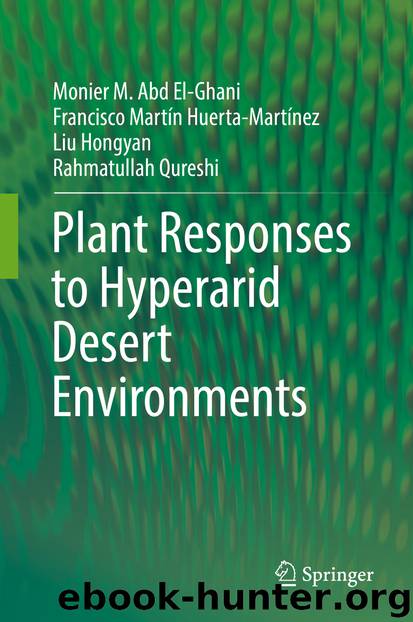Plant Responses to Hyperarid Desert Environments by Monier M. Abd El-Ghani Francisco Martín Huerta-Martínez Liu Hongyan & Rahmatullah Qureshi

Author:Monier M. Abd El-Ghani, Francisco Martín Huerta-Martínez, Liu Hongyan & Rahmatullah Qureshi
Language: eng
Format: epub
Publisher: Springer International Publishing, Cham
P% presence values, Per perennials, Ann annuals, L.F life form, Ph phanerophytes, H hemicryptophyte, Ch chamaephytes, Th therophytes, G geophytes, P parasites, SA Saharo–Arabian, SZ Sudano–Zambezian, IT Irano–Turanian, ES Euro–Siberian, ME Mediterranean
Figure 6.10 shows the life forms of the recorded species according to Raunkiaer (1937). The 69 recorded species were represented in five different life forms. Therophytes (31%) constitute the largest number of species (21 species). Chamaephytes have high value of 26% including 18 species, phanerophytes have 10 species representing about 14% of the flora, and hemicryptophytes represent about 26% of the flora with 18 species. Geophytes were represented by one species, namely, Panicum turgidum, and parasites were represented by one species, namely, Orobanche cernua.
Fig. 6.10Life-form spectrum of the recorded species in the study area. H hemicryptophytes , Ge geophytes, Ch chamaephytes , Th therophytes, Ph phanerophytes
Download
This site does not store any files on its server. We only index and link to content provided by other sites. Please contact the content providers to delete copyright contents if any and email us, we'll remove relevant links or contents immediately.
| Automotive | Engineering |
| Transportation |
Whiskies Galore by Ian Buxton(41882)
Introduction to Aircraft Design (Cambridge Aerospace Series) by John P. Fielding(33064)
Small Unmanned Fixed-wing Aircraft Design by Andrew J. Keane Andras Sobester James P. Scanlan & András Sóbester & James P. Scanlan(32744)
Craft Beer for the Homebrewer by Michael Agnew(18144)
Turbulence by E. J. Noyes(7940)
The Complete Stick Figure Physics Tutorials by Allen Sarah(7310)
Kaplan MCAT General Chemistry Review by Kaplan(6867)
The Thirst by Nesbo Jo(6829)
Bad Blood by John Carreyrou(6554)
Modelling of Convective Heat and Mass Transfer in Rotating Flows by Igor V. Shevchuk(6391)
Learning SQL by Alan Beaulieu(6212)
Weapons of Math Destruction by Cathy O'Neil(6148)
Man-made Catastrophes and Risk Information Concealment by Dmitry Chernov & Didier Sornette(5923)
Digital Minimalism by Cal Newport;(5665)
Life 3.0: Being Human in the Age of Artificial Intelligence by Tegmark Max(5475)
iGen by Jean M. Twenge(5367)
Secrets of Antigravity Propulsion: Tesla, UFOs, and Classified Aerospace Technology by Ph.D. Paul A. Laviolette(5309)
Design of Trajectory Optimization Approach for Space Maneuver Vehicle Skip Entry Problems by Runqi Chai & Al Savvaris & Antonios Tsourdos & Senchun Chai(5011)
Pale Blue Dot by Carl Sagan(4913)
